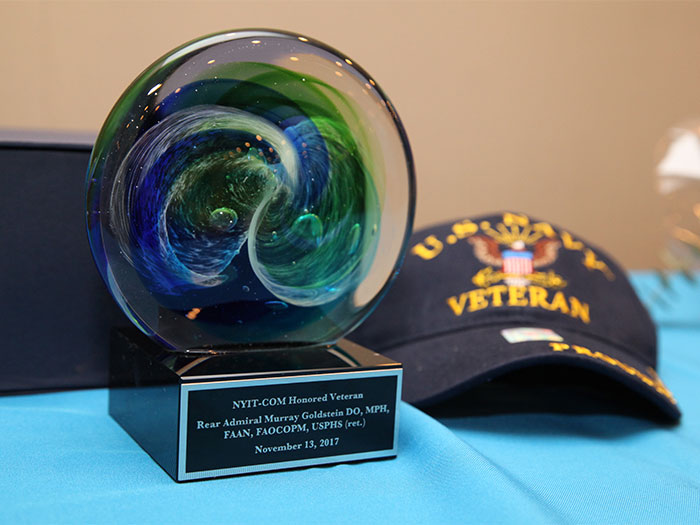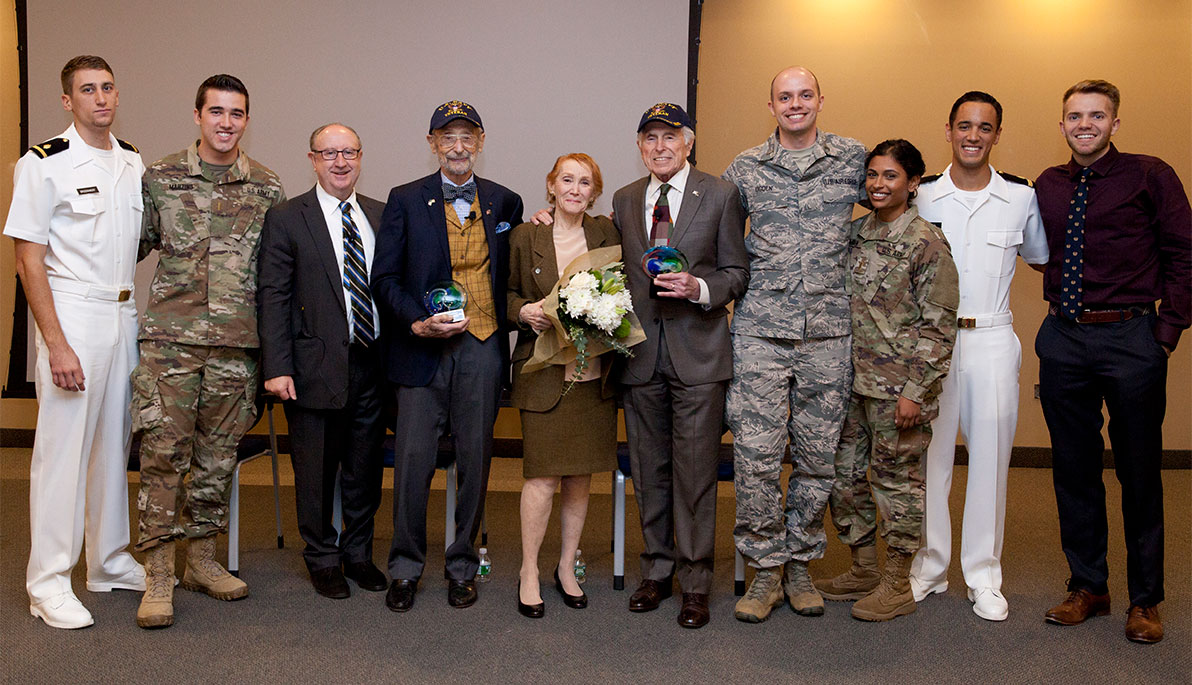News
Founder of NYITCOM Inspires Future D.O.s
November 17, 2017
Pictured: Dean Wolfgang Gilliar (third from left), Murray Goldstein (fourth from left), joined by Martin Diamond, D.O., and his wife, Connie, and students from the NYITCOM chapter of the Association of Military Osteopathic Physicians and Surgeons.
The field of osteopathic medicine has its origins in the 19th century, and over the decades that followed, practitioners had to fight for the recognition of their allopathic (M.D.) colleagues. The Murray Goldstein Founders Lecture is an annual seminar for second-year osteopathic medical students at NYITCOM to learn about the field, its history, and to imagine the future of the profession. This year’s event was particularly special since Murray Goldstein, D.O., himself spoke to the group.
Goldstein is a pioneer in osteopathic medicine and founder of NYIT College of Osteopathic Medicine (NYITCOM). He’s also a World War II veteran and recipient of the Purple Heart.
In his speech, Goldstein tasked the NYITCOM students with shaping the future of their field. “We have the opportunities to change and decide where we, as a profession, want to be and will be,” he said. “Most of those decisions will be made by you—not by us old timers. We’re the past. These changes will come about when you are in practice, when you are care givers, and when you will help decide where the profession should be.”
Goldstein also took the students on a journey through osteopathic medicine’s history. He asked students to remember the hurdles that their predecessors have overcome, including the efforts made to establish credibility for osteopathic medicine at a time when the profession faced scrutiny from allopathic (M.D.) physicians.
Since its inception in the 1870s, he noted, the field of osteopathic medicine has been met with resistance. “By the mid-1930s, D.O.s and M.D.s began to recognize each other,” he said. “By that time, there were five osteopathic medical schools in the country, each with its own hospital because D.O.s were not admitted into other hospitals.”
Goldstein reflected on his personal experience with “D.O. discrimination.” After graduating from Des Moines University College of Osteopathic Medicine in the early 1950s, for example, he went on to do his residency at an osteopathic hospital. Goldstein discovered that one of his patients had a brain tumor, which would need to be removed at another hospital under the care of a specialized surgeon. When Goldstein requested to observe his patient’s surgery, he was informed that would not be possible, simply because D.O.s were not permitted in that hospital.

Murray Goldstein, D.O., and Martin Diamond, D.O., were presented with hand-blown glass sculptures and veteran baseball caps following the discussion.
Despite the obstacles, Goldstein went on to break down barriers for the profession. His many notable achievements include being the first D.O. appointed as a commissioned medical officer in the uniformed services and to an institute of the National Institutes of Health (NIH), the first D.O. to be admitted to a U.S. school of public health, and the first to receive a fellowship at the Mayo Clinic and a presidential commendation.
Today’s students will not face the same challenges that Goldstein and his colleagues did, but the allopathic/osteopathic divide is still present, for example, D.O.s and M.D.s graduate from different medical schools. At the end of his presentation, Goldstein presented students with three possible pathways for moving the profession forward:
- Remain independent from allopathic medicine
- Join osteopathic and allopathic medical education, enabling students to select either a D.O. or M.D. degree upon graduation
- Convert all osteopathic medical schools to allopathic medical schools.
Most of the students favored the second option, and noted their preference for open exchange of ideologies between osteopathic and allopathic physicians.
The event also served as an opportunity to honor Veterans Day. Following the discussion, the NYITCOM Student Chapter of the Association of Military Osteopathic Physicians and Surgeons (AMOPS) honored Goldstein and Martin Diamond, D.O., who introduced Goldstein, a Korean War veteran and fellow trailblazer in osteopathic medicine, with hand-blown glass sculptures in recognition of their military service.
Wolfgang Gilliar, D.O., dean of NYITCOM, reminded students, “This is an incredibly special moment. These gentleman have done things that you might take for granted, such as an M.D. residency. We must remember that it was Dr. Goldstein who was the first D.O. to get an M.D. residency at the Mayo Clinic—he pushed that door open for you.”





